Transmission Replacement 6L50 All Wheel Drive
Note: NEW cooler pipe O-rings and torque converter bolts will be required each time the transmission is removed and installed.
Removal Procedure
- Raise and support the vehicle. Refer to Lifting and Jacking the Vehicle.
- Remove the exhaust system. Refer to Exhaust System Replacement.
- Remove the propeller shaft. Refer to Rear Propeller Shaft Replacement.
- Disconnect the shift linkage from the transmission.
- Disconnect the transmission wiring harness connector (5) from the transmission by releasing the locking mechanism and rotating the latch counterclockwise. Refer to Automatic Transmission Inline 16-Way Connector Description.
- Disconnect the wiring harness retainers (4) from the transmission.
- Remove the transmission vent hose from the retaining clips (6) on the transmission mount assembly.
- Remove the front air deflector. Refer to Front Air Deflector Replacement.
- Remove the transmission fluid cooler lines form the cooler line retainer bracket.
- Place an oil drain pan under the transmission fluid cooler pipes.
- Remove the transmission fluid cooler pipes from the transmission, and position aside. Refer to Transmission Fluid Cooler Pipe Replacement - Rear.
- Remove and discard the O-rings. Do NOT reuse the O-rings.
- Plug the open outlet ports to prevent fluid loss and contamination.
- Remove the transmission close out plug.
- Mark the torque converter to flexplate/flywheel orientation to ensure proper realignment.
- Remove the torque converter bolt close out cover from the engine block.
- Repeat the following steps for all 3 torque converter bolts:
- Disconnect the intermediate shaft from the power steering gear. Refer to Steering Gear Replacement.
- Support the transmission with a suitable transmission jack.
- Remove the transmission mount assembly. Refer to Transmission Mount Replacement.
- Support the rear of the front frame with adjustable jack stands.
- Remove the bolts at the rear of the front frame.
- Loosen the bolts at the front of the front frame two turns but do NOT remove the bolts.
- Lower the rear of the front frame and the transmission.
- Lower the transmission and remove the vent hose (2) from the vent tube.
- Position the wire harness and vent tube aside.
- Remove the transfer case. Refer to Transfer Case Assembly Replacement.
- Remove the top two transmission mounting bolts (1).
- Remove the right side transmission mounting bolts.
- Remove the left side transmission mounting bolts.
- Pull the transmission free from the engine dowels.
- Separate the transmission from the engine approximately 25.4 mm (1 in) to clear the starter drive nose cone.
- Carefully lower the transmission from the vehicle.
- Flush the transmission oil cooler if necessary. Refer to Transmission Fluid Cooler Flushing and Flow Test.
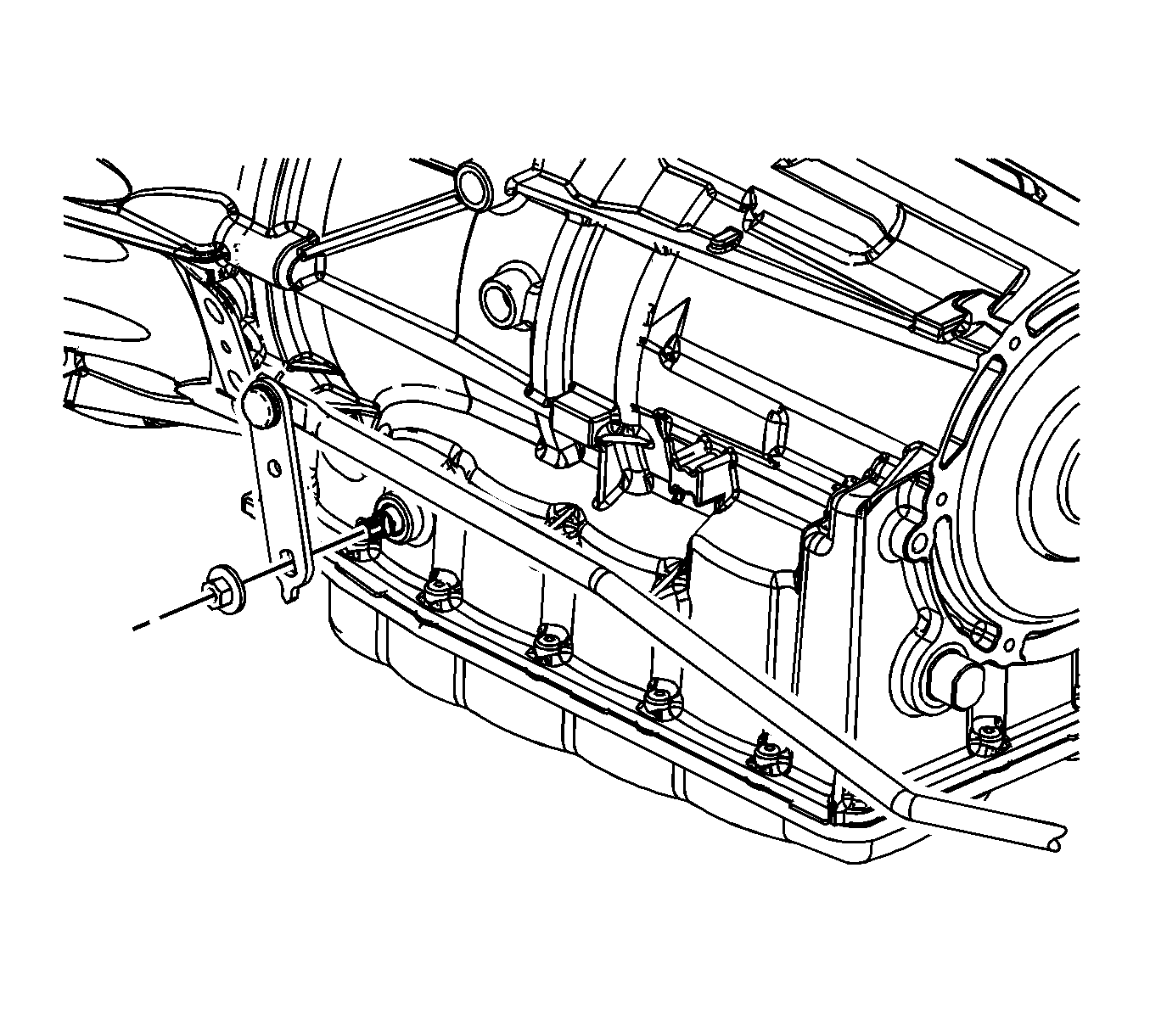

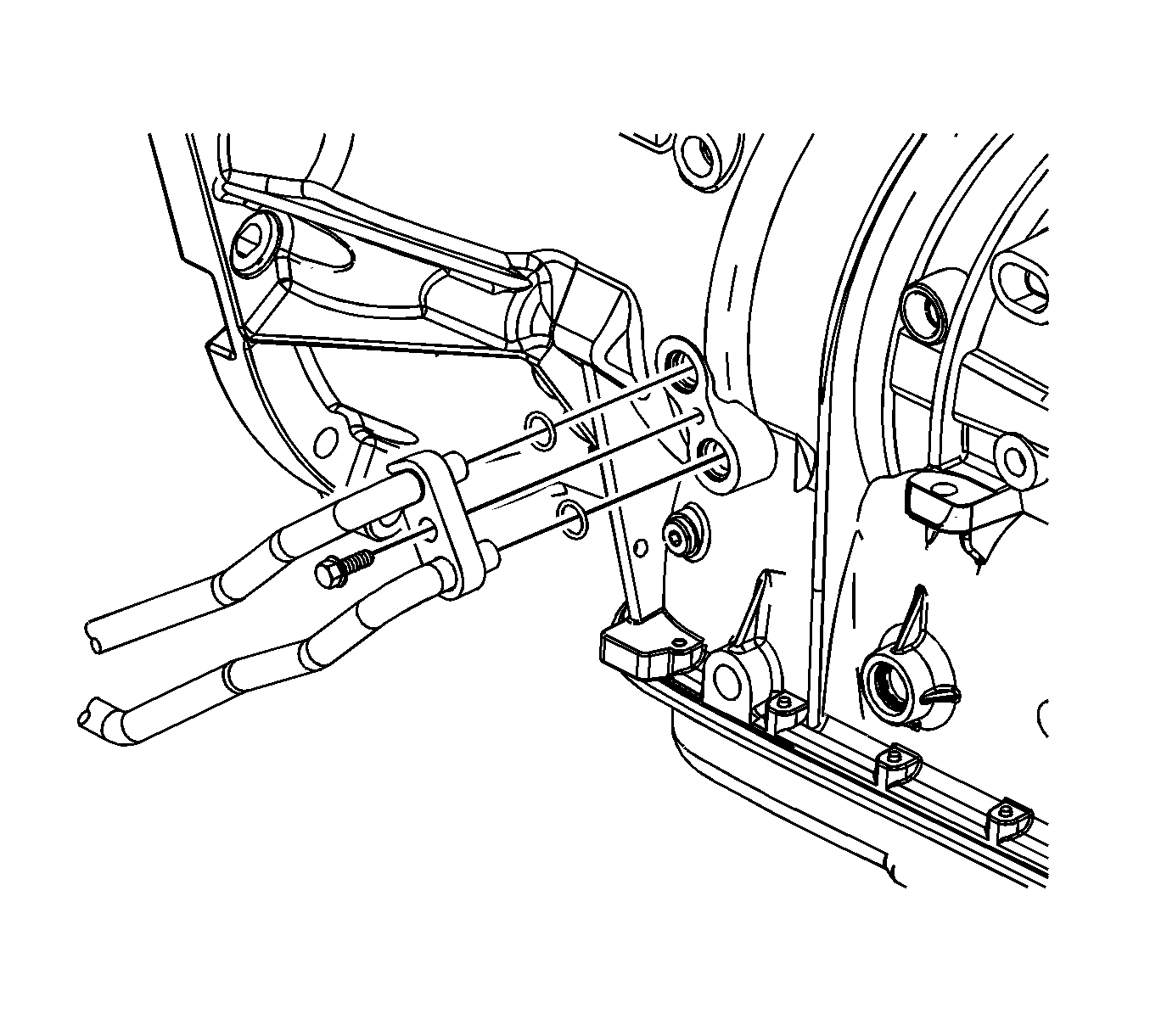
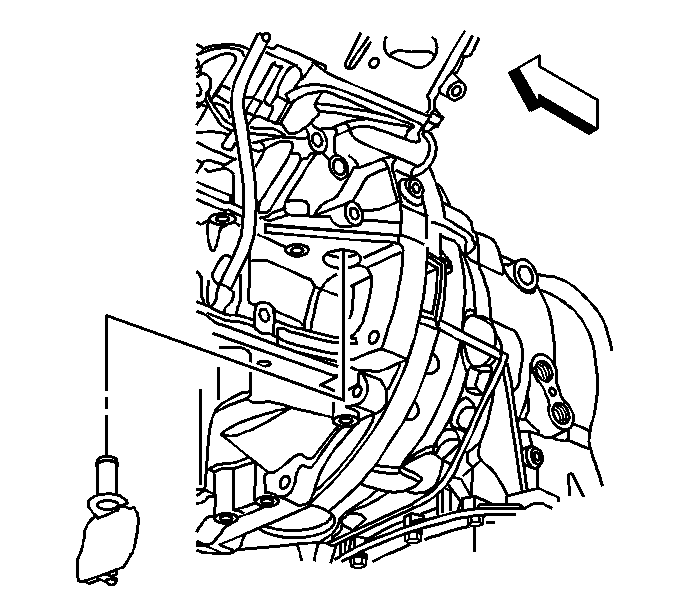
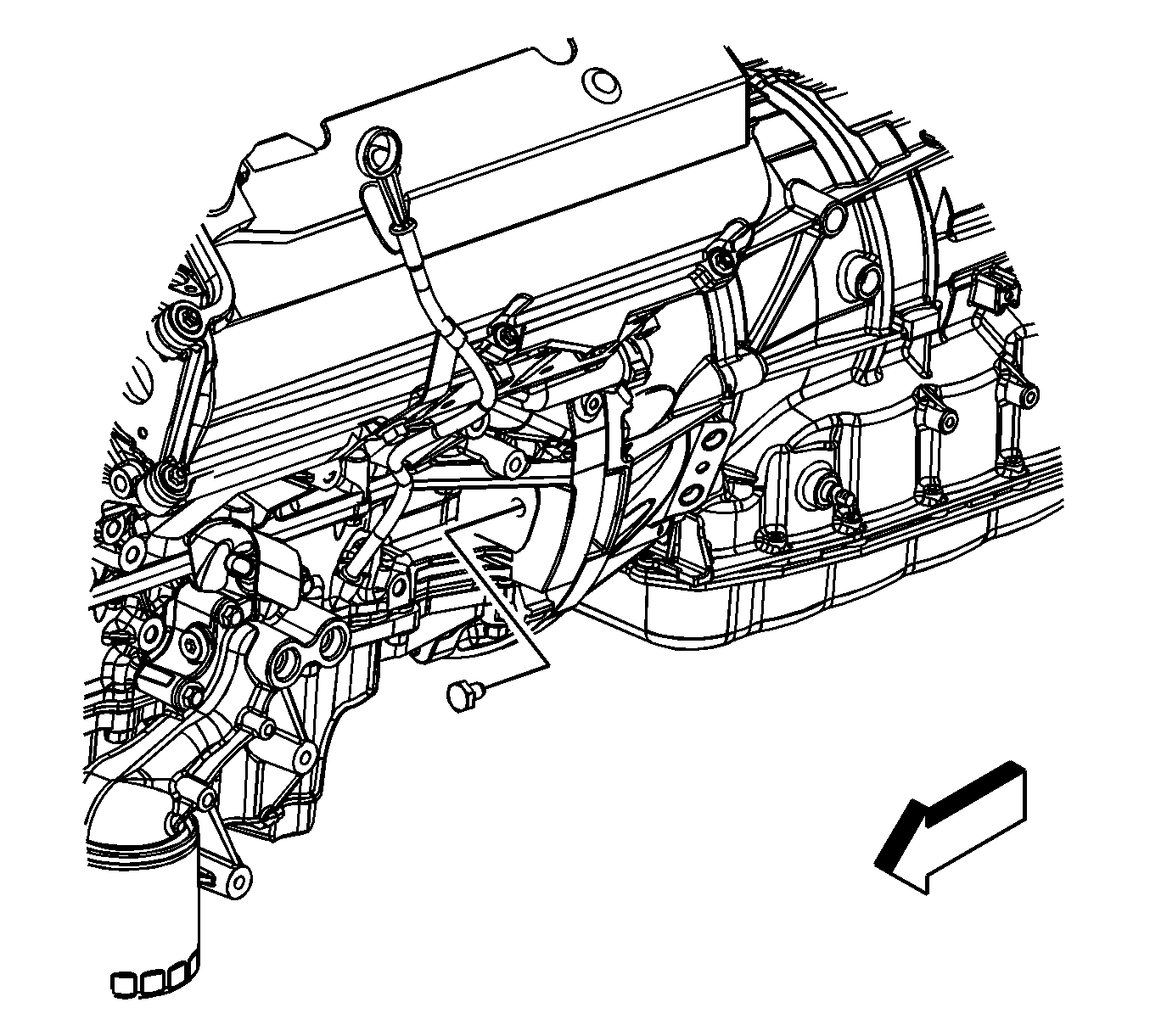
| 17.1. | Rotate the harmonic balancer center bolt clockwise ONLY, in order to align the torque converter bolt with the access hole. |
| 17.2. | Remove and discard the torque converter bolt. |
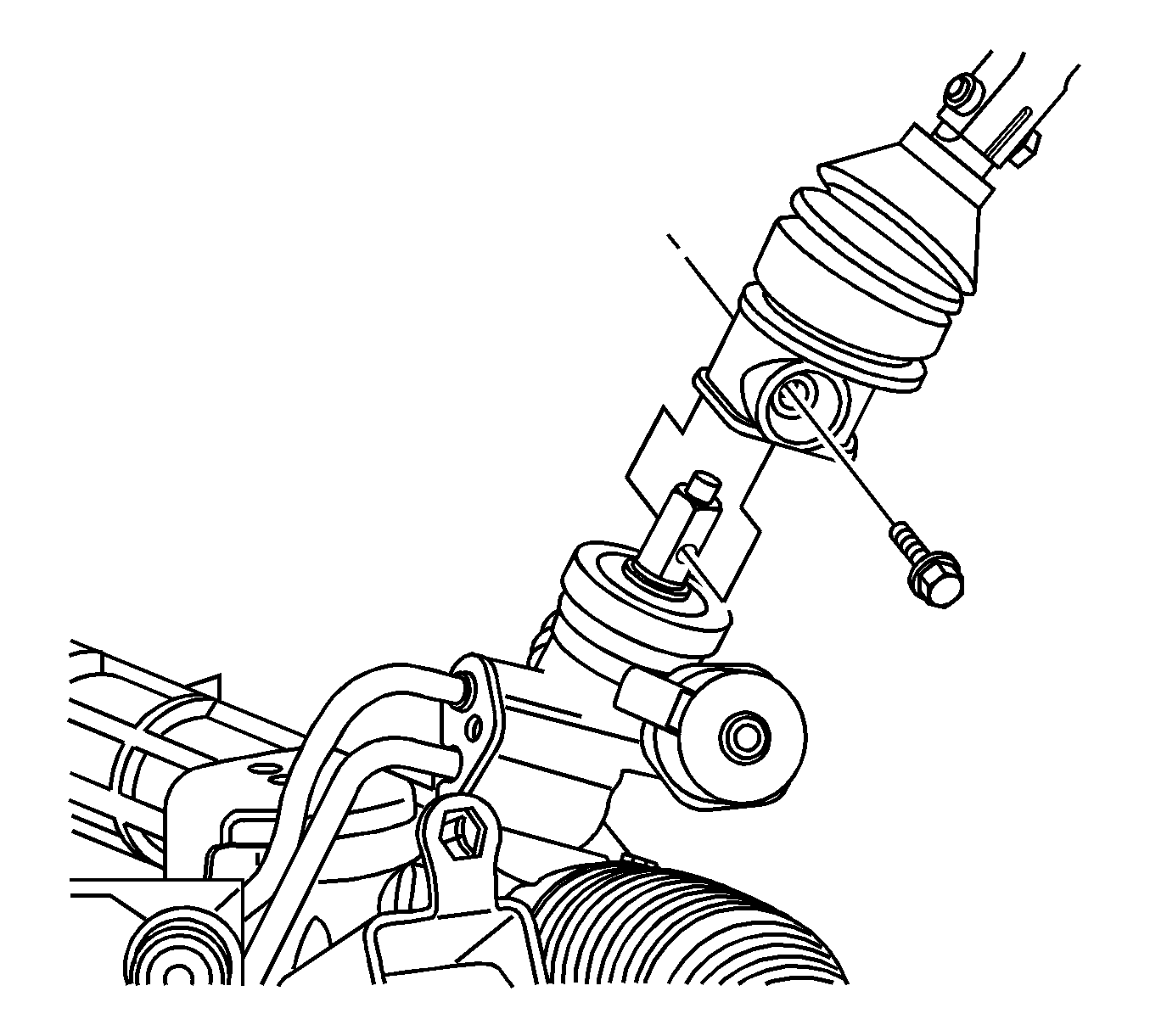
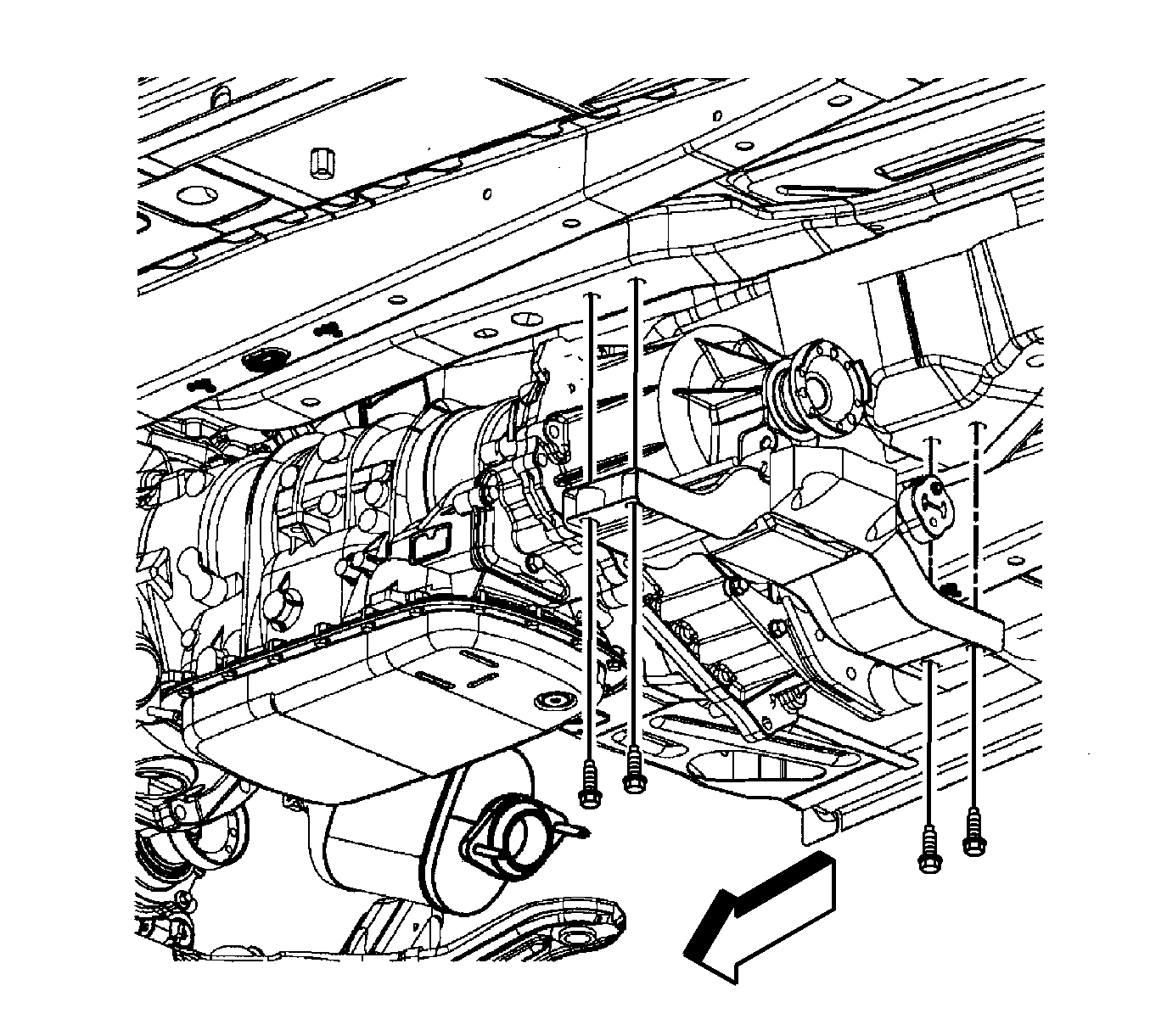

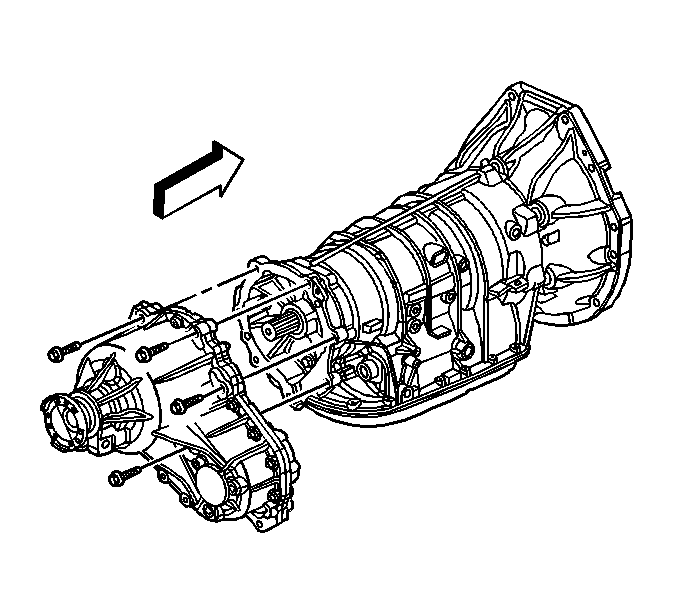
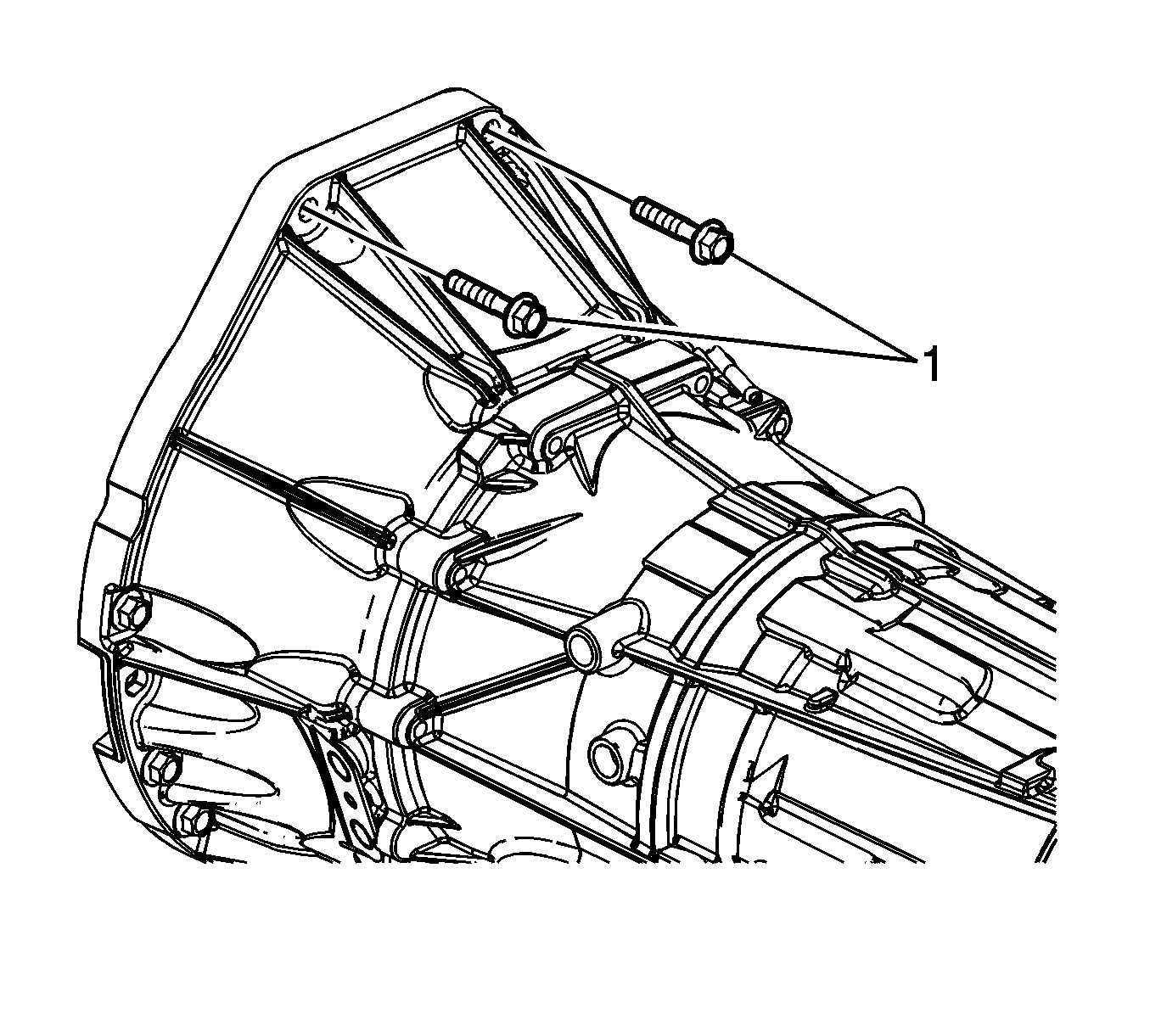
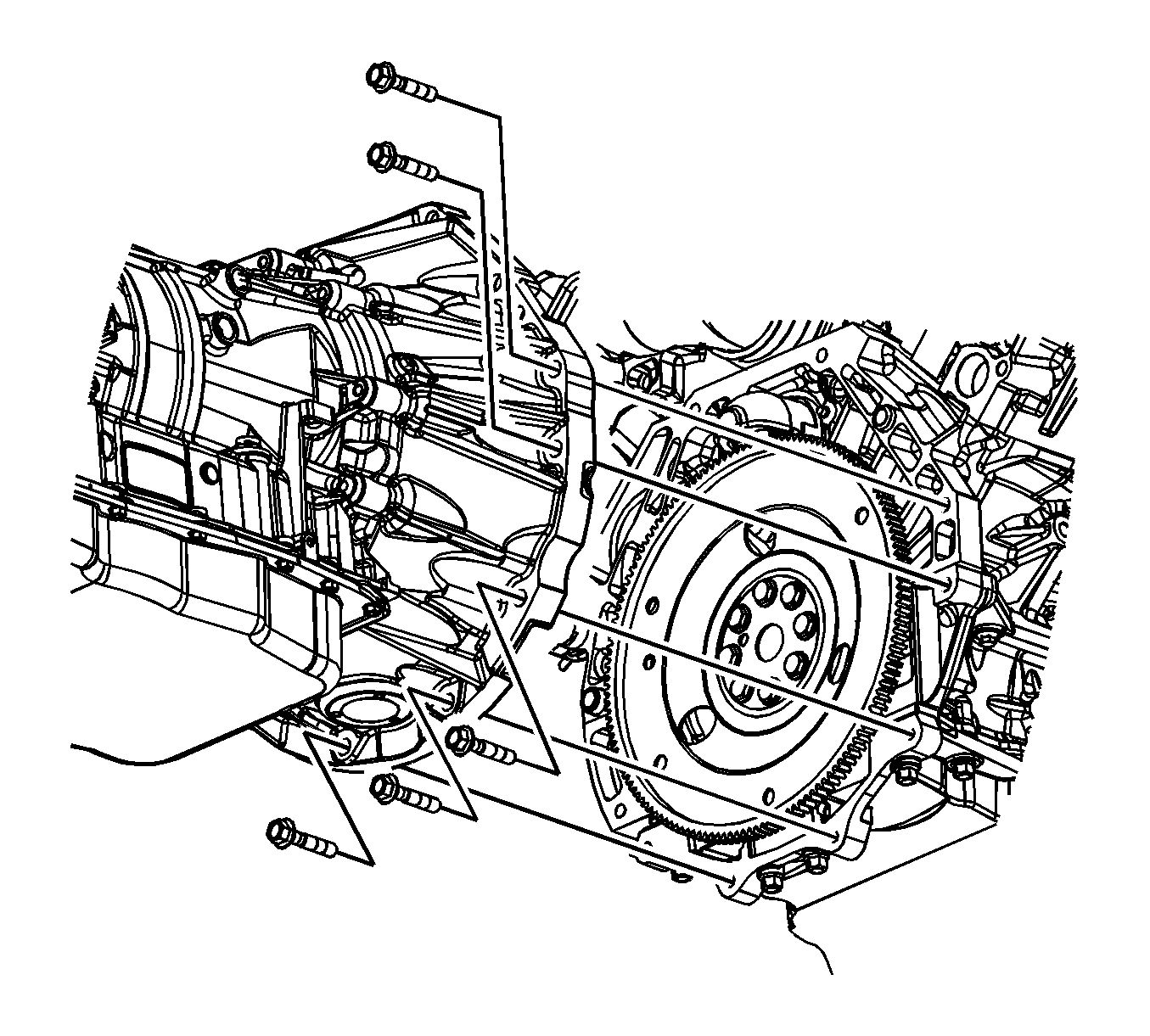
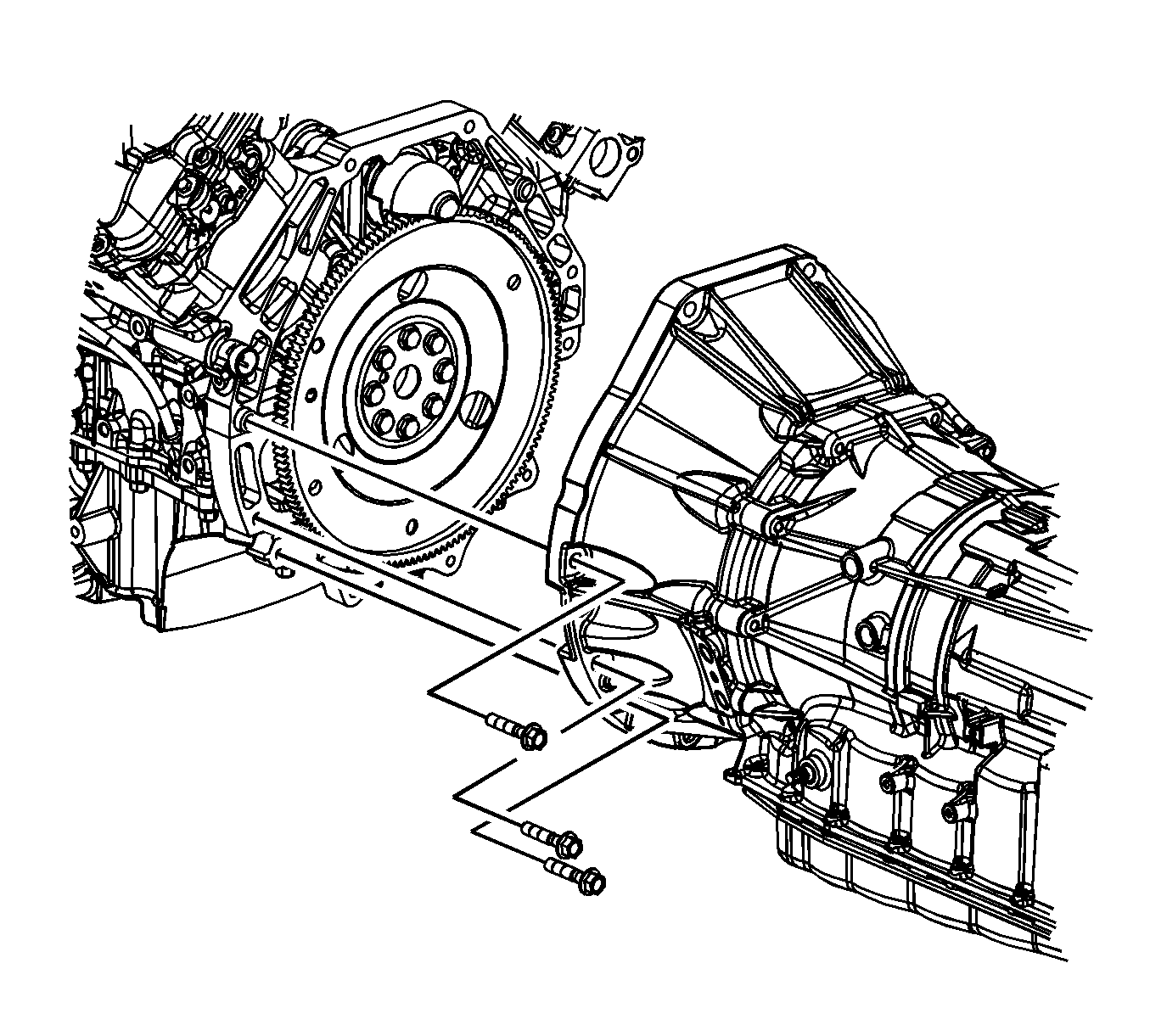
Note: Ensure clearance is maintained between the transmission and the following:
• The starter drive nose cone • The catalytic converters • The oxygen sensors • The wiring harnesses • The cooler pipes
Installation Procedure
- Using the transmission jack, carefully raise the transmission to meet the engine.
- Align the transmission with the engine dowels.
- Install the left side transmission mounting bolts. Do not tighten at this time.
- Install the right side transmission mounting bolts.
- Tighten the right and left side transmission mounting bolts and tighten to 50 N·m (37 lb ft).
- Install the top two transmission mounting bolts (1) and tighten to 50 N·m (37 lb ft).
- Install the transfer case. Refer to Transfer Case Assembly Replacement.
- Remove the support stand from under the engine oil pan.
- Using the transmission jack. Lower the engine and transmission assembly only enough to gain access to the vent hose tube.
- Install the vent hose (2) to the vent tube.
- Position the engine wiring harness to the original location.
- Raise the transmission to the installed position.
- Install the bolts at the rear of the front frame and properly torque all frame bolts. Refer to Front Frame Replacement for proper frame bolt tightening information.
- Install the transmission mount assembly. Refer to Transmission Mount Replacement.
- Remove the transmission jack.
- Connect the intermediate shaft to the power steering gear. Refer to Steering Gear Replacement.
- Align the torque converter to flexplate/flywheel orientation marks made during the removal procedure.
- Complete the following steps for all 3 torque converter bolts:
- Install the torque converter bolt close out cover to the engine block.
- Install the transmission close out plug.
- Place NEW O-rings over the transmission fluid cooler pipes.
- Install the transmission fluid cooler pipes to the transmission. Refer to Transmission Fluid Cooler Pipe Replacement - Rear.
- Install the transmission fluid cooler lines to the cooler line retainer bracket.
- Install the front air deflector. Refer to Front Air Deflector Replacement.
- Install the transmission vent hose to the retaining clips (6) on the transmission mount assembly.
- Install the wiring harness retainers (4) to the transmission.
- Connect the transmission wiring harness connector (5) to the transmission by rotating the locking latch clockwise.
- Install the shift linkage to the transmission. Refer to Transmission Control Replacement.
- Install the propeller shaft. Refer to Rear Propeller Shaft Replacement.
- Install the exhaust system. Refer to Exhaust System Replacement.
- Lower the vehicle.
- Check the transmission fluid level and fill if necessary. Refer to Transmission Fluid Check.
- Adjust the shift control linkage. Refer to Shift Control Linkage Adjustment.
Note: Ensure clearance is maintained between the transmission and the following:
• The starter drive nose cone • The catalytic converters • The oxygen sensors • The wiring harnesses • The cooler pipes


Caution: Refer to Fastener Caution in the Preface section.






Note: Torque converter bolts are self locking and must be replaced with NEW torque converter bolts every time the bolts are removed.
| 18.1. | Rotate the harmonic balancer center bolt clockwise ONLY, in order to align the torque converter bolt holes in the flexplate/flywheel with the access hole in the engine block. |
| 18.2. | To aid in alignment of the torque converter to the flexplate/flywheel. Install all 3 NEW torque converter bolts before fully tightening then tighten to 63 N·m (46 lb ft). |




Transmission Final Test and Inspection
Complete the following procedure after the transmission is installed in the vehicle:
- With the ignition OFF or disconnected, crank the engine several times. Listen for any unusual noises or evidence that any parts are binding.
- Start the engine and listen for abnormal conditions.
- While the engine continues to idle, raise and support the vehicle. Refer to Lifting and Jacking the Vehicle.
- Inspect for fluid leaks while the engine is idling.
- Perform a final inspection for the proper fluid level.
- Lower the vehicle.
- Reset the TAP values. Refer to Transmission Adaptive Functions.
- Road test the vehicle.
- Calibrate the transmission control module (TCM). Refer to Control Module References.
Note: It is recommended that transmission adaptive pressure (TAP) information be reset.
Resetting the TAP values using a scan tool will erase all learned values in all cells. As a result, The ECM, PCM or TCM will need to relearn TAP values. Transmission performance may be affected as new TAP values are learned.Transmission Replacement 6L50 Rear Wheel Drive
Note: NEW cooler pipe O-rings and torque converter bolts will be required each time the transmission is removed and installed.
Removal Procedure
- Raise and support the vehicle. Refer to Lifting and Jacking the Vehicle.
- Remove the exhaust system. Refer to Exhaust System Replacement.
- Remove the propeller shaft. Refer to Rear Propeller Shaft Replacement.
- Disconnect the shift linkage from the transmission.
- Disconnect the transmission wiring harness connector (5) from the transmission by releasing the locking mechanism and rotating the latch counterclockwise. Refer to Automatic Transmission Inline 16-Way Connector Description.
- Disconnect the wiring harness retainers (4) from the transmission.
- Remove the transmission vent hose from the retaining clips (6) on the transmission mount assembly.
- Remove the front air deflector. Refer to Front Air Deflector Replacement.
- Remove the transmission fluid cooler lines form the cooler line retainer bracket.
- Place an oil drain pan under the transmission fluid cooler pipes.
- Remove the transmission fluid cooler pipes from the transmission, and position aside. Refer to Transmission Fluid Cooler Pipe Replacement - Rear.
- Remove and discard the O-rings. Do NOT reuse the O-rings.
- Plug the open outlet ports to prevent fluid loss and contamination.
- Remove the transmission close out plug.
- Mark the torque converter to flexplate/flywheel orientation to ensure proper realignment.
- Remove the torque converter bolt close out cover from the engine block.
- Repeat the following steps for all 3 torque converter bolts:
- Disconnect the intermediate shaft from the power steering gear. Refer to Steering Gear Replacement.
- Support the transmission with a suitable transmission jack.
- Remove the transmission mount assembly. Refer to Transmission Mount Replacement.
- Support the rear of the front frame with adjustable jack stands.
- Remove the bolts at the rear of the front frame.
- Loosen the bolts at the front of the front frame two turns but do NOT remove the bolts.
- Lower the rear of the front frame and the transmission.
- Remove the vent hose (2) from the vent tube.
- Position the wire harness and vent tube aside.
- Remove the top two transmission mounting bolts (1).
- Remove the right side transmission mounting bolts.
- Remove the left side transmission mounting bolts.
- Pull the transmission free from the engine dowels.
- Separate the transmission from the engine approximately 25.4 mm (1 in) to clear the starter drive nose cone.
- Carefully lower the transmission from the vehicle.
- Flush the transmission oil cooler if necessary. Refer to Transmission Fluid Cooler Flushing and Flow Test.

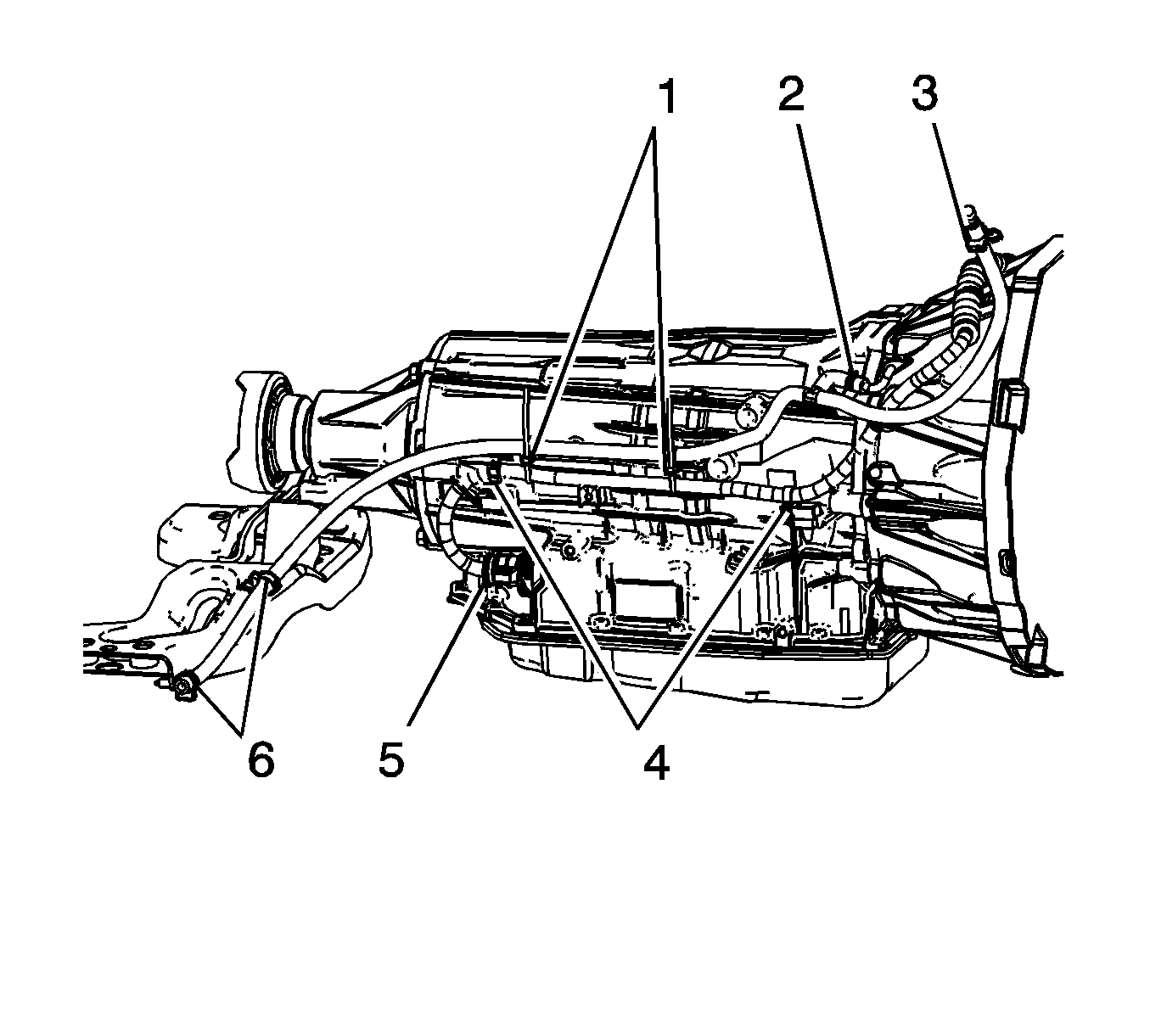



| 17.1. | Rotate the harmonic balancer center bolt clockwise ONLY, in order to align the torque converter bolt with the access hole. |
| 17.2. | Remove and discard the torque converter bolt. |

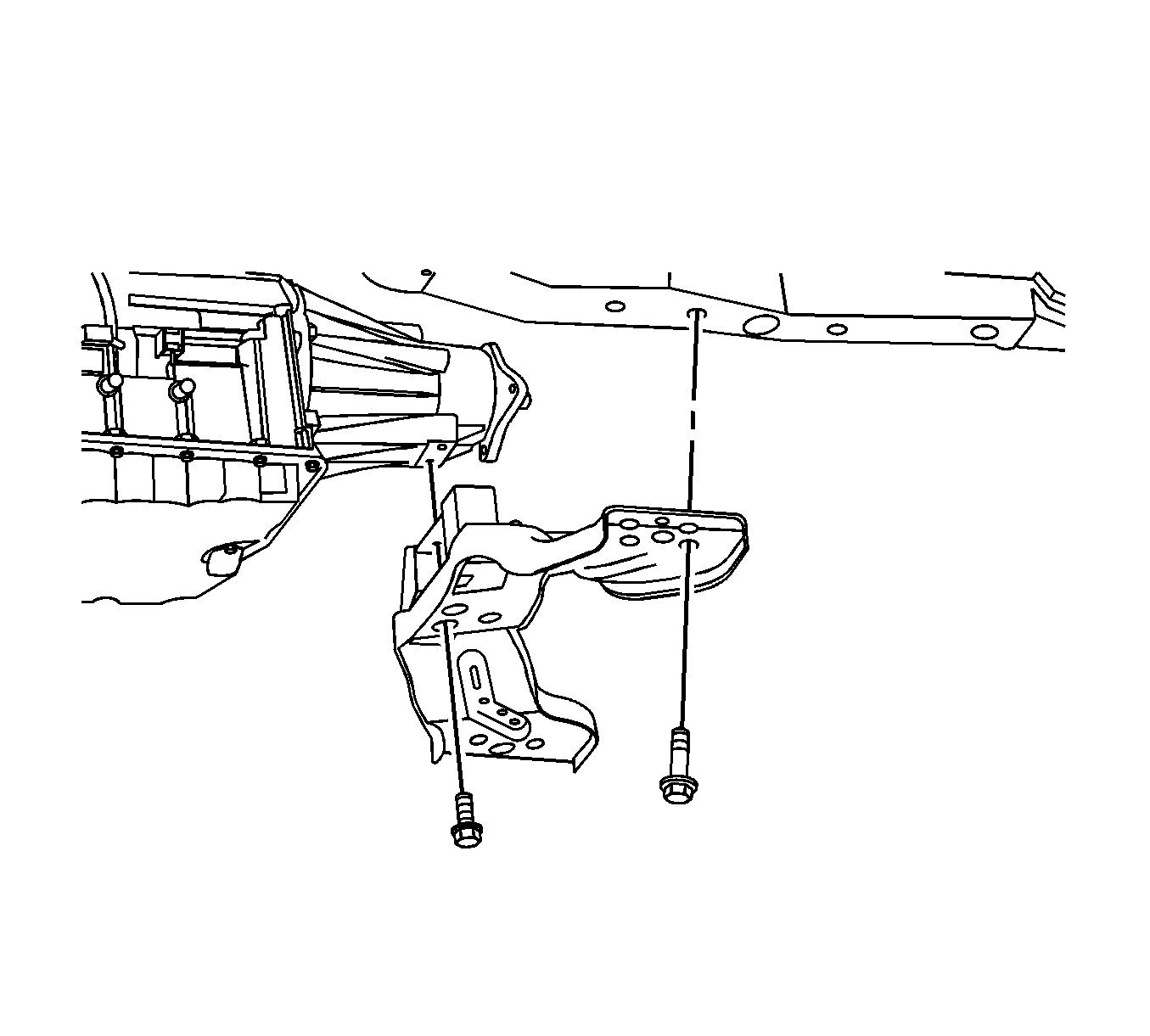




Note: Ensure clearance is maintained between the transmission and the following:
• The starter drive nose cone • The catalytic converters • The oxygen sensors • The wiring harnesses • The cooler pipes
Installation Procedure
- Using the transmission jack, carefully raise the transmission to meet the engine.
- Align the transmission with the engine dowels.
- Install the left side transmission mounting bolts. Do not tighten at this time.
- Install the right side transmission mounting bolts.
- Tighten the right and left side transmission mounting bolts and tighten to 50 N·m (37 lb ft).
- Install the top two transmission mounting bolts (1) and tighten to 50 N·m (37 lb ft).
- Install the vent hose (2) to the vent tube.
- Position the engine wiring harness to the original location.
- Raise the transmission and front frame to the installed position.
- Install the bolts at the rear of the front frame and properly torque all frame bolts. Refer to Front Frame Replacement for proper frame bolt tightening information.
- Install the transmission mount assembly. Refer to Transmission Mount Replacement.
- Remove the jacks from under the transmission and frame.
- Connect the intermediate shaft to the power steering gear. Refer to Steering Gear Replacement.
- Align the torque converter to flexplate/flywheel orientation marks made during the removal procedure.
- Complete the following steps for all 3 torque converter bolts:
- Install the torque converter bolt close out cover to the engine block.
- Install the transmission close out plug.
- Place NEW O-rings over the transmission fluid cooler pipes.
- Install the transmission fluid cooler pipes to the transmission. Refer to Transmission Fluid Cooler Pipe Replacement - Rear.
- Install the transmission fluid cooler lines to the cooler line retainer bracket.
- Install the front air deflector. Refer to Front Air Deflector Replacement.
- Install the transmission vent hose to the retaining clips (6) on the transmission mount assembly.
- Install the wiring harness retainers (4) to the transmission.
- Connect the transmission wiring harness connector (5) to the transmission by rotating the locking latch clockwise.
- Install the shift linkage to the transmission. Refer to Transmission Control Replacement.
- Install the propeller shaft. Refer to Rear Propeller Shaft Replacement.
- Install the exhaust system. Refer to Exhaust System Replacement.
- Lower the vehicle.
- Check the transmission fluid level and fill if necessary. Refer to Transmission Fluid Check.
- Adjust the shift control linkage. Refer to Shift Control Linkage Adjustment.
Note: Ensure clearance is maintained between the transmission and the following:
• The starter drive nose cone • The catalytic converters • The oxygen sensors • The wiring harnesses • The cooler pipes


Caution: Refer to Fastener Caution in the Preface section.





Note: Torque converter bolts are self locking and must be replaced with NEW torque converter bolts every time the bolts are removed.
| 15.1. | Rotate the harmonic balancer center bolt clockwise ONLY, in order to align the torque converter bolt holes in the flexplate/flywheel with the access hole in the engine block. |
| 15.2. | To aid in alignment of the torque converter to the flexplate/flywheel. Install all 3 NEW torque converter bolts before fully tightening. |
Tighten the torque converter bolts to 63 N·m (46 lb ft).




Transmission Final Test and Inspection
Complete the following procedure after the transmission is installed in the vehicle:
- With the ignition OFF or disconnected, crank the engine several times. Listen for any unusual noises or evidence that any parts are binding.
- Start the engine and listen for abnormal conditions.
- While the engine continues to idle, raise and support the vehicle. Refer to Lifting and Jacking the Vehicle.
- Inspect for fluid leaks while the engine is idling.
- Perform a final inspection for the proper fluid level.
- Lower the vehicle.
- Reset the TAP values. Refer to Transmission Adaptive Functions.
- Road test the vehicle.
- Calibrate the transmission control module (TCM). Refer to Control Module References.
Note: It is recommended that transmission adaptive pressure (TAP) information be reset.
Resetting the TAP values using a scan tool will erase all learned values in all cells. As a result, The ECM, PCM or TCM will need to relearn TAP values. Transmission performance may be affected as new TAP values are learned.Transmission Replacement 6L80
Removal Procedure
- Remove the front and rear sections of the supercharger inlet duct assembly. Refer to Supercharger Inlet Duct Assembly Replacement.
- Remove the wire harness (1) from the wire harness bracket.
- Remove the top two transmission mounting bolts (1).
- Raise and support the vehicle. Refer to Lifting and Jacking the Vehicle.
- Remove the exhaust system. Refer to Exhaust System Replacement.
- Remove the propeller shaft. Refer to Rear Propeller Shaft Replacement.
- Disconnect the shift linkage from the transmission.
- Disconnect the transmission wiring harness connector (8) from the transmission by releasing the locking mechanism and rotating the latch counterclockwise. Refer to Automatic Transmission Inline 16-Way Connector Description.
- Disconnect the wiring harness retainers (7, 9) from the transmission.
- Remove the transmission vent hose from the retaining clips (1, 2) on the transmission mount assembly.
- Remove the front air deflector. Refer to Front Air Deflector Replacement.
- Remove the transmission fluid cooler lines form the cooler line retainer bracket.
- Place an oil drain pan under the transmission fluid cooler pipes.
- Remove the transmission fluid cooler pipes from the transmission, and position aside. Refer to Transmission Fluid Cooler Pipe Replacement - Rear.
- Remove and discard the O-rings. Do NOT reuse the O-rings.
- Plug the open outlet ports to prevent fluid loss and contamination.
- Remove the transmission close out plug.
- Mark the torque converter to flexplate/flywheel orientation to ensure proper realignment.
- Remove the torque converter bolt close out cover from the engine block.
- Repeat the following steps for all 3 torque converter bolts:
- Support the transmission with a suitable transmission jack.
- Remove the transmission mount assembly. Refer to Transmission Mount Replacement.
- Lower the transmission and remove the vent hose (5) from the vent tube.
- Position the wire harness and vent tube aside.
- Using the transmission jack. Raise the engine and transmission assembly to the normal position.
- Place a support stand under the rear of the engine oil pan to keep the engine level while removing the transmission.
- Remove the right side transmission mounting bolts.
- Remove the left side transmission mounting bolts.
- Pull the transmission free from the engine dowels.
- Separate the transmission from the engine approximately 25.4 mm (1 in) to clear the starter drive nose cone.
- Carefully lower the transmission from the vehicle.
- Flush the transmission oil cooler if necessary. Refer to Transmission Fluid Cooler Flushing and Flow Test.
Note:
• NEW cooler pipe O-rings and torque converter bolts will be required each time the transmission is removed and installed. • The top two transmission mounting bolts must be accessed from the engine compartment.
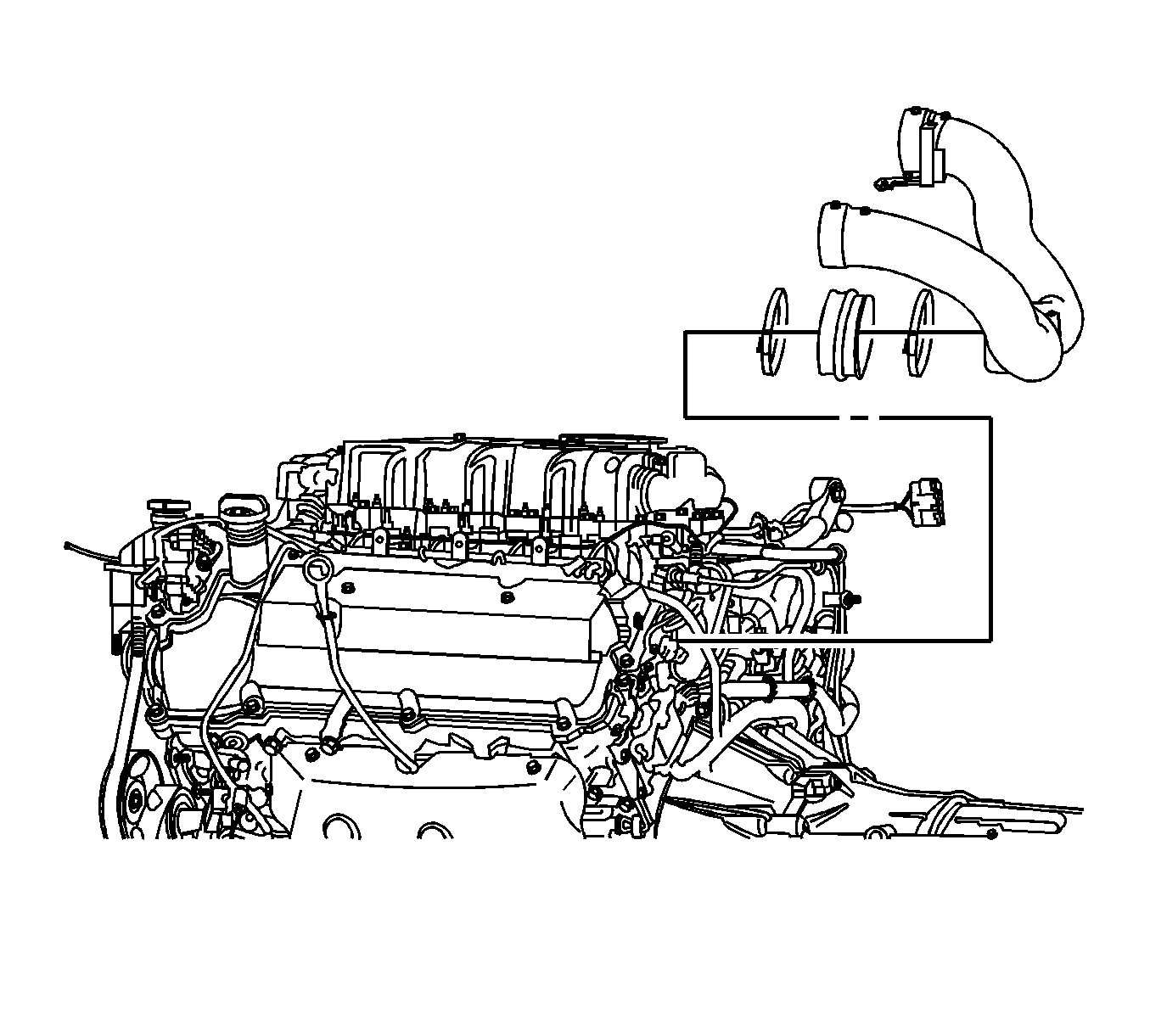

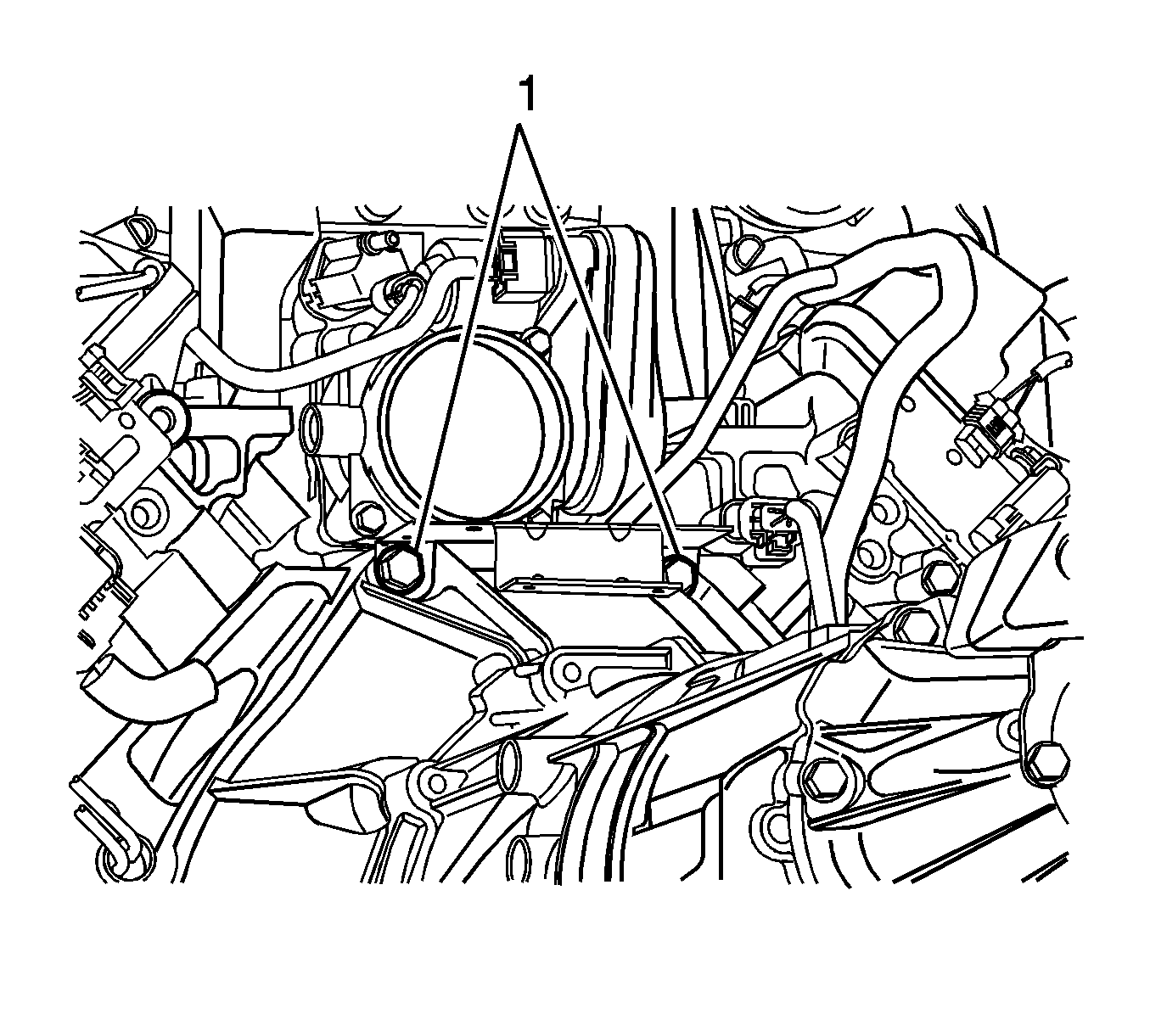

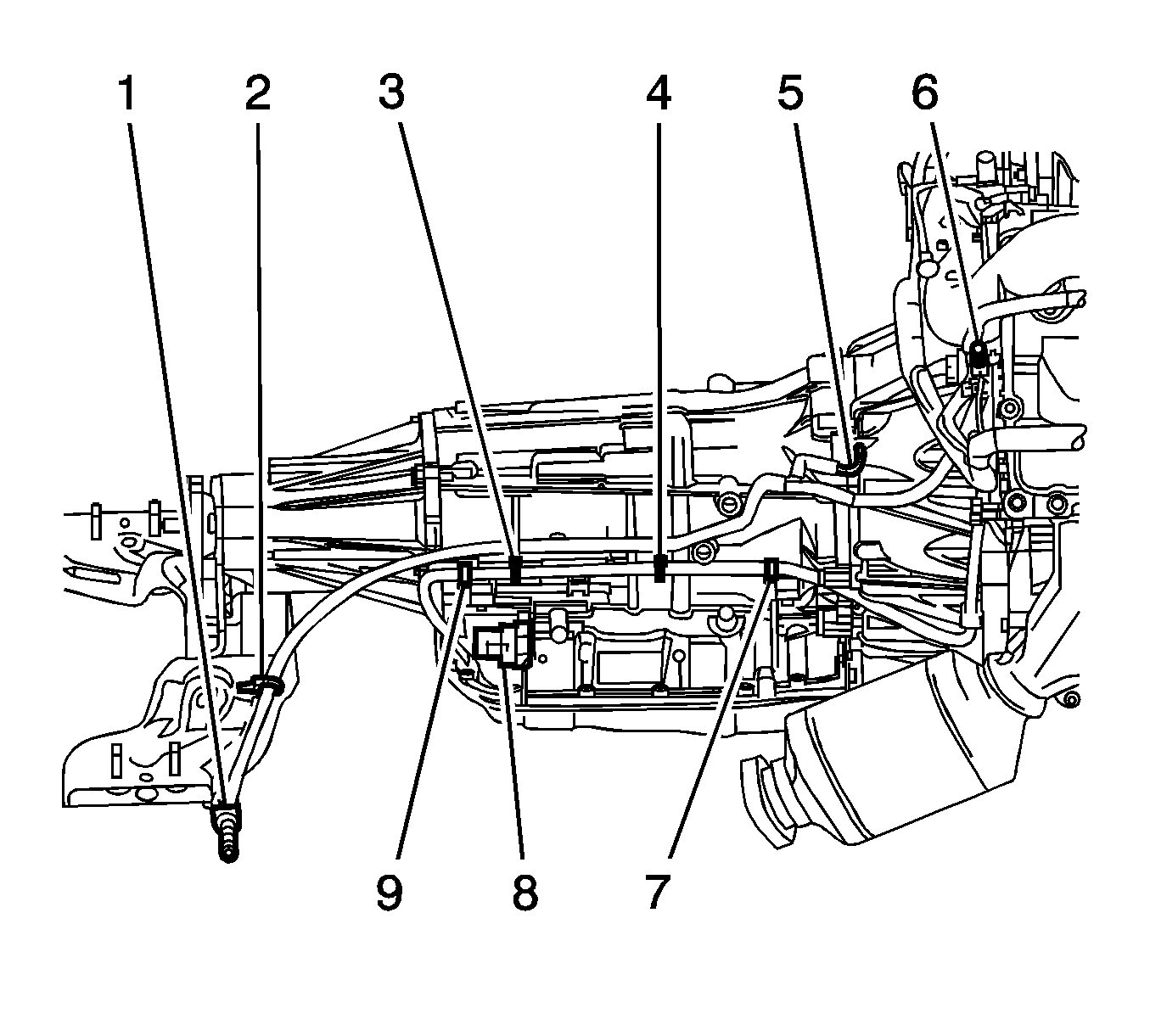



| 20.1. | Rotate the harmonic balancer center bolt clockwise ONLY, in order to align the torque converter bolt with the access hole. |
| 20.2. | Remove and discard the torque converter bolt. |





Note: Ensure clearance is maintained between the transmission and the following:
• The starter drive nose cone • The catalytic converters • The oxygen sensors • The wiring harnesses • The cooler pipes
Installation Procedure
- Using the transmission jack, carefully raise the transmission to meet the engine.
- Align the transmission with the engine dowels.
- Install the left side transmission mounting bolts. Do not tighten at this time.
- Install the right side transmission mounting bolts.
- Tighten the right and left side transmission mounting bolts to 50 N·m (37 lb ft).
- Remove the support stand from under the engine oil pan.
- Using the transmission jack. Lower the engine and transmission assembly only enough to gain access to the vent hose tube.
- Install the vent hose (5) to the vent tube.
- Position the engine wiring harness to the original location.
- Raise the transmission to the installed position.
- Install the transmission mount assembly. Refer to Transmission Mount Replacement.
- Remove the transmission jack.
- Align the torque converter to flexplate/flywheel orientation marks made during the removal procedure.
- Complete the following steps for all 3 torque converter bolts:
- Install the torque converter bolt close out cover to the engine block.
- Install the transmission close out plug.
- Place NEW O-rings over the transmission fluid cooler pipes.
- Install the transmission fluid cooler pipes to the transmission. Refer to Transmission Fluid Cooler Pipe Replacement - Rear.
- Install the transmission fluid cooler lines to the cooler line retainer bracket.
- Install the front air deflector. Refer to Front Air Deflector Replacement.
- Install the transmission vent hose to the retaining clips (1, 2) on the transmission mount assembly.
- Install the wiring harness retainers (7, 9) to the transmission.
- Connect the transmission wiring harness connector (8) to the transmission by rotating the locking latch clockwise.
- Install the shift linkage to the transmission. Refer to Transmission Control Replacement.
- Install the propeller shaft. Refer to Rear Propeller Shaft Replacement.
- Install the exhaust system. Refer to Exhaust System Replacement.
- Lower the vehicle.
- Install the top two transmission mounting bolts (1) and tighten to 50 N·m (37 lb ft).
- Install the wire harness (1) to the wire harness bracket.
- Install the front and rear sections of the supercharger inlet duct assembly. Refer to Supercharger Inlet Duct Assembly Replacement.
- Check the transmission fluid level and fill if necessary. Refer to Transmission Fluid Check.
- Adjust the shift control linkage. Refer to Shift Control Linkage Adjustment.
Note: Ensure clearance is maintained between the transmission and the following:
• The starter drive nose cone • The catalytic converters • The oxygen sensors • The wiring harnesses • The cooler pipes


Caution: Refer to Fastener Caution in the Preface section.



Note: Torque converter bolts are self locking and must be replaced with NEW torque converter bolts every time the bolts are removed.
| 14.1. | Rotate the harmonic balancer center bolt clockwise ONLY, in order to align the torque converter bolt holes in the flexplate/flywheel with the access hole in the engine block. |
| 14.2. | To aid in alignment of the torque converter to the flexplate/flywheel. Install all 3 NEW torque converter bolts before fully tightening. |
Tighten the torque converter bolts to 63 N·m (46 lb ft).







Transmission Final Test and Inspection
Complete the following procedure after the transmission is installed in the vehicle:
- With the ignition OFF or disconnected, crank the engine several times. Listen for any unusual noises or evidence that any parts are binding.
- Start the engine and listen for abnormal conditions.
- While the engine continues to idle, raise and support the vehicle. Refer to Lifting and Jacking the Vehicle.
- Inspect for fluid leaks while the engine is idling.
- Perform a final inspection for the proper fluid level.
- Lower the vehicle.
- Reset the TAP values. Refer to Transmission Adaptive Functions.
- Road test the vehicle.
- Calibrate the transmission control module (TCM). Refer to Control Module References.
Note: It is recommended that transmission adaptive pressure (TAP) information be reset.
Resetting the TAP values using a scan tool will erase all learned values in all cells. As a result, The ECM, PCM or TCM will need to relearn TAP values. Transmission performance may be affected as new TAP values are learned.